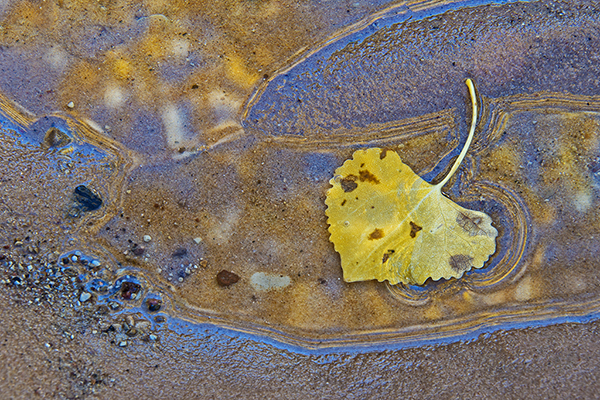The Upper Slickrock of Zion National Park is an incredible maze of towering Navajo Sandstone monuments and mesas cut by narrow and sometimes deeply incised watercourses that hold pockets of run-off which nourish the micro-environments of cottonwood, gamble oak, sawtooth maple, rabbitbrush, Indian paintbrush, and others that flourish there. Gravity at work here ultimately sends everything it can to the Virgin River more than a thousand feet below. The Upper Slickrock is an amazing place for creative effort. In early November the beautiful yellows of the cottonwoods carpet the floors of the watercourses and in a passing storm, leaves come down by the thousands to swim in the pools that await them. As the skies clear, what is reflected are the shades of blue mingled with the leaves that still cling to trees overhead. I wanted to isolate a single leaf, submerged, or partly so, in a shallow pool. I knew that in open shade, the camera’s sensor would more readily “see” the blue on the edges of the water, and I chose my settings so as to render the single leaf sharply focused while showing the reflected leaves with just sufficient detail to create a sense of their presence. The warm tones of the sand added just the color contrast I was seeking, and the small, gritty pebbles added context. A focal length of 262mm isolated the angle-of-view I wanted. An aperture of f/22 allowed me to choose my point of focus and depth-of-field carefully; and a shutter speed of 0.6 seconds at ISO 100 gave me an overall slightly lighter-than-medium exposure. The absolute stillness of the air allowed for the shutter speed I mentioned, since the surface tension of the water was not a problem for that shutter duration.

Beautiful composition Don.
Very cool
This is Mother Nature showing off. I am glad you found this little jewel and shared it with us. I like the shape of the leaf, the curl on the stem and it’s position. The first thing I saw was the beautiful colors, then the leaf and how it was creating beautiful lines, then the auras of blue and gold made the image really magical.
Absolutely perfect! Eliot Porter could not have done it better!
Subtle beauty!
This is lovely, a true intimate landscape.
Hello Everyone,
Thank you all for joining me for this Image. This one was really a lot of fun, primarily because the elements were already in place and my challenge was to determine the best expression of the potential relationships. Having waterpockets on slickrock is never anything but creation ab initio. Drew, I’m glad to hear from you. Thanks for your kind words. Hey, Lynn. I’ll take “very cool” as a very good thing; thanks. Going from waterfall to waterpocket can sometimes be a good stretch, so I’m glad you liked both ends of the spectrum. Nancy T., thanks for all of your kind words. It was fortunate that I could be there with the cottonwood leaves coming down in numbers. It made finding “pretty” ones much easier. The colors and the lines you mention were also what attracted me; and also the shape of the narrow little spit of sand cutting into the waterpocket from the top right. I was also aware of the textures of water and sand as I worked to make the relationships turn out as I wanted them. I believe that little scenes like this one are always magical. Ah, Pat, you are too kind, but I am grateful. To be in the same sentence with Eliot is magical in itself. I hope you are ready for a beautiful winter in Western Mass. Hey Linda, thank you very much. Subtlety is such a wonderful quality, especially when its presence can be detected. Joel, I’ve been waiting to see if any of my recent Images would meet your criteria for intimacy. Thank you. I hope your healing continues to go well, and I appreciate your taking the time to join me. Thank you all, again. There are so many ways to express beauty in this world; and we all have different ideas sometimes of what constitutes that “beauty.” I do think there are certain universal principles by which any image can be examined with the result that beauty can take many forms and present itself with innumerable faces as long as the principles are thoughtfully applied.